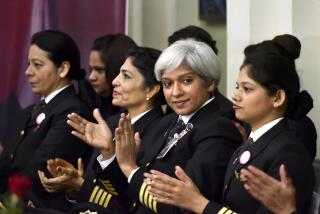Flight attendant’s job can be a grind, but this veteran still loves it
- Share via
Reporting from Dallas — It’s a two-Hershey-bar trip for Kristen Heller.
Nine flights hopscotching six cities over 48 hours; for fliers, it’s an itinerary that reads like a dare.
For Heller, it’s long enough to earn her two of her guilty-pleasure treats. But the 6,450 air miles aren’t an unusual “sequence” for the American Airlines flight attendant to fly. As the breadwinner in her family at the moment, Heller flies as many hours as she can each month because flight attendants, like pilots, get paid only for the time the planes are moving.
The candy bars — she likes them with almonds — are her special treat on the road to help take the edge off what’s become a grinding career for flight attendants.
Gone are the jet-set days when the job was its own passport to exotic shores — when flight attendants were the stars of air-carrier advertising. Now most airline flight attendants, having given back money and benefits to help keep their carriers financially aloft in the last decade, work more hours to earn their old salaries and face new security-related duties and planes that are fuller than ever.
Heller, who has been a flight attendant for nearly two decades, still loves the job.
“It is still fun,” she said. “I still even get excited about takeoff; isn’t that so corny? I’m totally about the takeoff.”
Some flight attendants are more about the landing and exit. When a JetBlue Airways flight attendant in August screamed at passengers, grabbed beers from a beverage cart and slid down an evacuation chute, it put a spotlight on a profession and its pressures.
Globe-trotting whimsy, adventure and even high fashion have given way to a job that can be a grind.
Heller’s average schedule has her flying 80 to 85 hours a month and, though that might sound cushy, it actually puts her on the road 16 to 18 days a month. When she flew an international schedule from American’s Miami base, she was often out for 21 days a month.
The glamour attracted her to the job as a 21-year-old; today, at age 40, it’s a bit harder to find the thrill.
“This doesn’t happen every day, but I just got a bag of vomit handed to me,” she said in the back of an MD-80 flying from Dallas/Fort Worth International Airport to Portland, Ore. Later in that same flight, a passenger hands her a dirty diaper to throw away.
As the airline industry has been squeezed for profits, flight attendants find themselves up in the air longer, managing more irate passengers and scanning rows for suspicious behavior.
“If there’s glamour still in this job, I don’t really see it,” said Laura Glading, a New York-based flight attendant who serves as the president of the Assn. of Professional Flight Attendants. Having to work harder to earn the previous levels of income, along with more responsibilities and a coarser flying public, can create fatigue.
“I feel very motherly about it, but in my position I think our members are flying a very, very unhealthy lifestyle,” Glading said. She has a hard time recommending the profession to people interesting in flying. “I think it’s gotten tougher for the fliers too, but for our members the job has been a real struggle.”
Heller’s feet pay a heavy price for the job’s long work hours; she wears 2-inch Aerosoles heels and is on them for much of every flight, pushing a beverage cart up and down the aisle and walking the cabin at least every 15 minutes.
With carriers such as American and its competitors having eliminated niceties for coach passengers, she’s forced to help passengers understand the new economic reality.
“ ‘Yes’ is really easy,” Heller said. “‘No’ takes a lot more explanation. I get to say ‘I’m sorry’ a lot,” she said. “ ‘I’m sorry we don’t have a pillow or a blanket for you.’”
Among the annoyances she faces are passengers asking for help lifting overstuffed carry-ons into overhead bins. Heller suggests that there could be chivalrous men on board to help; she can’t afford a back injury that would sideline her and eat into her pay.
The proliferation of electronics on board keeps flight attendants busier than ever on takeoffs and landings, as safety rules require that such gadgets be turned off. “I’ve literally had to show people how to turn their iPods off,” she said.
Heller’s weapon in this never-ending battle: an inexhaustible smile supply.
A little back-of-the-beverage-napkin work on her part estimates that on an MD-80 flying four times a day she’s bringing at least 1,100 smiles a day, and they come naturally. She brushes aside shoulder-length hair to show them off when she leans in for a drink order.
That’s a lot of smiles for not a lot of pay.
American says flight attendant pay ranges widely, from less than $24,000 for someone flying the minimum number of monthly hours needed to get full benefits to more than $73,000 for a senior flight attendant who flies international routes.
American’s top-scale flight attendants earn $46 to $49 an hour depending on whether they fly internationally — but remember that they’re flying 70 to 80 hours a month. Southwest Airlines and Continental Airlines flight attendants have the only higher hourly wage rates.
For Heller, the nine flights on this trip will net her about 18.5 hours of paid flight time, plus $1.25 an hour per diem for the time she’s on duty.
She says a flight attendant with her experience and schedule usually earns about $38,000 a year, which is just above the pay range for an average flight attendant given by the APFA.
Flight attendants at American can control their schedules through the bidding process, in which they tell airline schedulers what kind of flying and generally what days they’d like to work.
The airline’s scheduling program takes in all the bid requests and crunches out a schedule; flight attendants soon figure out what kind of work they can “hold” with their seniority, given that the most senior workers get their pick of American’s routes.
If flight attendants don’t like what the computer gives them, they can try to trade out of trips they don’t want or add more flying than they’re given.
Many flight attendants pick a sequence of flights like the one Heller did and do it several times a month because they like the routine; others like the variety of different airports and routings each month. And most flight attendants can be called upon on short notice to fly.
Heller typically bids the No. 1 position out of three on her crew, meaning she serves first class and deals with more frequent fliers. She’s still among the more junior ranks of American’s 16,000 flight attendants but has enough seniority to hold that position. Some flight attendants don’t like working the “front of the plane,” but for her, it’s a chance to interact more with fliers and shape their experience.
“They’re really easy to please up there,” she said. “When we’re delayed, they know there’s really nothing that any of us can do to make it go away or make it go any faster.”
Heller usually bids for flights on weekends and those that start early in the morning, as she’s often up at 5 a.m. This trip, she was up even earlier to see her family off on a trip.
Her first flight on this trip leaves a bit late, at 4:57 p.m. First stop is Memphis, then it’s back to Dallas before flying on to Portland, where she’ll be at a Radisson hotel at 1:30 a.m. Dallas time. It’s the first of two overnight stays on the trip; she’ll spend the next night in Minneapolis and will also make stops in Austin and Chicago.
The hotels and airports go by fast enough that there’s barely any time to feel a sense of place when you’re on the road. Portland didn’t feel much different from Minneapolis the next night. Memphis didn’t even smell like barbecue, as the airport often can.
Heller remembers her favorite layover — a sunny trip to Bainbridge Island near Seattle, where she and fellow crew members sipped microbrews while overlooking a harbor. But most of the trips she flies are like this one: busy, with sleep at a premium.
“I’m surprised how good I feel,” she said on board the flight to Portland as the first day nears an end. She’s helped by an ability to fall asleep almost immediately to catch crucial winks before Friday morning’s check-in at Portland International Airport.
Torbenson writes for the Dallas Morning News/McClatchy.
More to Read
Sign up for The Wild
We’ll help you find the best places to hike, bike and run, as well as the perfect silent spots for meditation and yoga.
You may occasionally receive promotional content from the Los Angeles Times.






